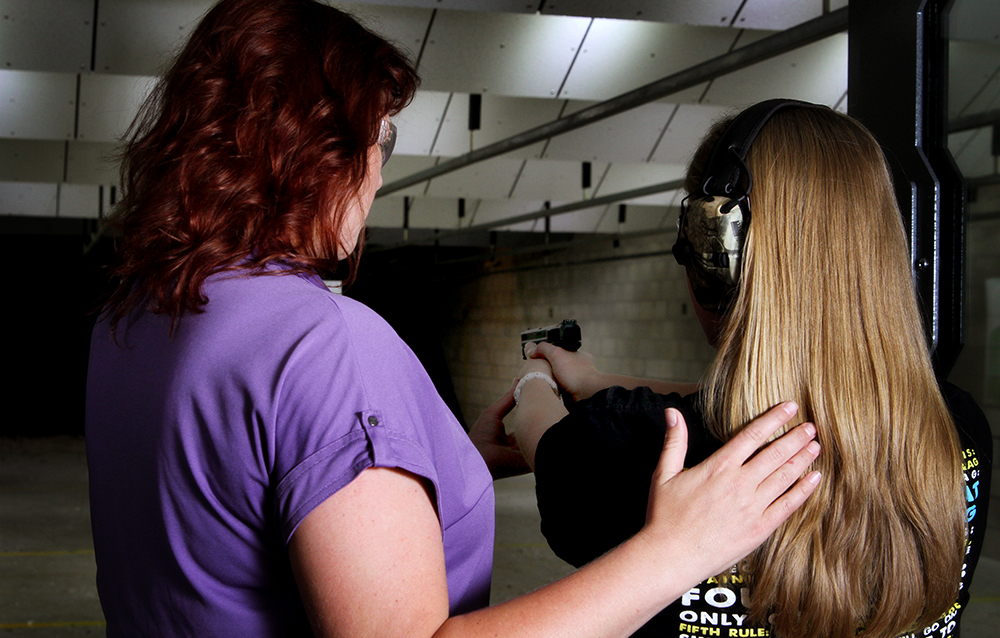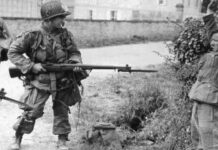The word phobia is defined as an extreme or irrational fear of or aversion to something. You may or may not identify yourself as having a true gun phobia, maybe just a fear of the unknown, nervous because you don’t know anything about firearms or what to expect the first time you fire a gun. If your only exposure to firearms is what you see on TV and movies, which has created a perception and understanding that guns are bad and scary, that is a reasonable fear. Or you may 100%, no doubt about it, have an overwhelming fear brought on by a subconscious or conscious life experience. Either way we are here to address the unknowns of firearms, learn how to anchor the fear and anxiety you may be feeling, and turn this into an empowering moment in your life. It is just a piece of machinery, a tool if you will. When you learn how to control the tool, the tool no longer controls you.
Identify Your Level of Fear
We’ve all heard the regular advice – things like ‘be well prepared’, ‘relax’, ‘remember to breathe’ – and all this advice is great if you only have mild anxiety.
But if you are experiencing real FEAR – that overwhelming feeling of anxiety or nervousness that makes you sick to your stomach – you are experiencing an ‘unwarranted automated fear response’ which no amount of trying to relax or breathing will help.
What makes people afraid?
• Have been embarrassed by someone, usually a family member or close friend.
• Witnessed someone making a fool of themself or being unsafe, and you think “I will never put myself in that situation.”
• Stems from lack of opportunity during adolescence to develop self confidence.
• Product of your environment. If you were not raised around guns, you are less likely to appreciate them.
How we create fear – and every other emotion
The first thing to understand is how we create fear in the human nervous system. The way you feel at any moment in time is a direct result of two things: Focus and your Physiology.
Focus is the way you are using your mind: your beliefs, what you are thinking about, and the language you use inside your head to describe things to yourself.
Physiology is the way you are using your body: your posture, your breathing, and even things like how tired you are and whether you have been drinking lots of coffee (very bad) or water (very good).
Every feeling you ever have is a result of the precise strategy composed of the different elements of Focus & Physiology you are using at that moment. The good news is that you can change the recipe almost instantaneously if it is one that causes you anxiety.
Anchoring
The Simple Subtle Powerful Strategy for Overcoming Phobias and Fears
Whenever something unique happens and you are in an intense emotional state (good or bad), your nervous system creates a link between the two and it creates a snapshot to remember.
For example, the first time you fell in love, there may have been a song that you heard on the radio. At the time that unique song played over and over again, you were in the intense emotional state of being in love, and now whenever you hear that song that feeling of falling in love comes back.
Anchoring is tapping into the very same part of your nervous system that is causing the gun phobia/fears in the first place. The quickest way to stop fear in the short term is to quickly and radically change what you are doing. If you are sitting still thinking what will happen if it all goes wrong, remember a time when you felt incredibly powerful, centered, and strong. Your feelings could change immediately or over a short period of time.
The questions we ask ourselves will open the door to conquering our fears. A question like, “What will happen if this all goes wrong?” will generate answers that feel terrible and you are less likely to participate in the activity and unfortunately making an anchored negative emotional response stronger. Instead ask, “How can I make this incredible?” or “How will others benefit when I overcome this?” This is life-changing and can shift how you feel in a heartbeat, changing the anchored response to a positive.
Change the Physiology and the Focus, and immediately the feeling changes. I compare it to a German shepherd (or any working dog) that are naturally programed to do more than sit around all day because they NEED to work. They can get bossy or destructive if their needs for physical and mental activity are not met with walks or time at the dog park. Our brain can be compared to a working dog. It needs to have a job. If you have a fear of guns the brain automatically assumes its job is to protect you from the experience of shooting: The loud noise, the recoil. You close your eyes, you flinch. But, if you give your brain a job by putting it to work by focusing on your sight picture, concentrating on your trigger press and holding your position for the follow through, you will find that you can quickly overcome anything from major anxiety to simple marksmanship mistakes. Remembering to breath and oxygenate the body will help you to control these fine motor skills.
In both cases the same thing happened: your mind created a link and a snapshot – an anchor – between a powerful feeling (love or firing the gun) and a unique stimulus (the song or the sensation of the recoil).
The way to use anchoring to transform your gun phobia is to create a deliberate link between some kind of unique stimulus – one you control and can initiate whenever you want – and a powerful mixture of the kind of calm, confident emotions you want to experience instead of gun phobia.
Then, and this is the magical part, you simply apply the stimulus while thinking about firearms and your mind will build a new map of the emotions that belong with firearms. Literally, your mind will create new neural pathway attaching the new positive emotions in place of the old.
The job here is to bundle together a collection of overwhelmingly positive powerful emotions you can call up whenever you want. Now when you are in a situation in which you would previously have been afraid, you are feeling confident.
What to expect
Stage Fright
After your instructor has covered the safety rules, showed you how to operate the firearm and done some dryfire drills, it is time to load up and take that first shot. You may find that you get in and out of your stance, grip and re grip the gun, take a few breaths, put your finger on the trigger, start to press and then – stop. It is ok. Remember give your brain a job to do – focus, breathe, and press.
Tearful Moment
It is not unusual for a person to take their first shot and experience a tearful moment. These tears are produced in response to that strong emotion you have experienced from stress, pleasure, relief, anger or sadness and are released the moment you pull the trigger. Tears contain a natural painkiller, called leucine enkephalin – perhaps, part of the reason why you might feel better after a good cry.
Gain Confidence
As you continue in the process, repeat with the same level of attention and dedication to the each time. Make sure you are recording the experience in your subconscious brain correctly. As you gain muscle memory you will start to move a bit faster, more confidently through the process and want to challenge yourself for what’s next!
The instructor makes all the difference.
Having the experience to associate firearms with exhilaration and empowerment while breaking and overcoming your gun phobia or fear is critical. Here are 7 tips for creating a positive range experience:
1. Talk to others. Talking to others about their experiences will help normalize what you are thinking and feeling. Often times we think that we are alone, that no one else has ever felt the way we feel.
2. Find the right Instructor. Take time to research instructors in your area. Talk to family and friends to find out if they have a favorite instructor. Ask if they would send their daughter or mother to the same trainer and why.
3. Meet the Instructor before you sign up. Ask if you may audit a portion of class before you actually attend. This gives you the opportunity to and see how the instructor interacts with others and if you will be comfortable in his/her presence, and review their teaching philosophy. Keep in mind that the instructor may not be accustomed to letting “non-paying” observation of their class, so make sure you say you only want to observe about 20 mins and will not interfere with the class in progress.
4. What to expect from your Instructor. The instructor should take the time to find out what level you are at ensuring the correct class for you, or can adjust instruction. Make sure your instructor is open minded to make physical adjustments as you need them, won’t yell if you aren’t doing it right, and will make sure you are ready for the curriculum. Keep in mind any safety violations can result in extremely firm tones and statements. The instructor’s job is to keep you safe, no compromises there. But at all times you and the instructor should have mutual respect.
5. Schedule a Private Lesson. The ideal learning environment is 1:1. Especially if you are feeling any level of anxiety. This will allow time and space to ask your questions and work at your own pace. 1 hour is sufficient time for a private lesson learning just the basics of marksmanship. After the initial lesson you can decide if you want to join a group class or continue with private lessons.
6. Tell the instructor your story. Your story is unique, but at the same time your story is similar to so many others and chances are your instructor has dealt with your situation before. It may be you are fearful of the noise or sensation of the recoil, it may be you have been a victim of gun violence or been affected by a traumatic incident. This will help your instructor be prepared to appropriately deal with your specific needs during class and be prepared for your physical and psychological reactions.
7. Bring a friend. When women are stressed about everyday life things they often turn to girlfriends to vent, talk, problem-solve, and get support. We know that they won’t judge us and feel safe being vulnerable.
Girl’s Night Out
For many women who are fearful of guns, it is beneficial to attend one of our Girl’s Night Outs (GNOs). AG & AG has GNOs at over 130 ranges across the country. All of our GNOs are hosted by certified instructors, so women of all experience levels can attend and get quality information as well as meet other women. Many women find the AG & AG community experience invaluable because it is not only casual and welcoming, but it is a judgment-free zone where women can ask questions about shooting, conceal carry, safe storage in the home, and other concerns.
With weekly #TrainingTipTuesday emails, AG & AG members receive information on shooting techniques and personal safety. Members are a part of an enthusiastic and knowledgeable community of women who offer support and encouragement. AG & AG currently hosts national, regional, and local events at over 130 ranges. If there is not a chapter near you, you can join at the national level, start a chapter in your community, or utlize the AG & AG Shooting Journal, which serves as a virtual personal instructor to teach you safe gun handling, with monthly live-fire, dry-fire, and journaling drills that not only document your improvements in marksmanship but track how your empowerment on the range affects every area of your life.
AG & AG has more than 5,000 members nationwide. Join us today at www.AGirlandAGun.org!
SOURCE ARTICLE: https://www.agirlandagun.org/overcoming-gun-phobia/




